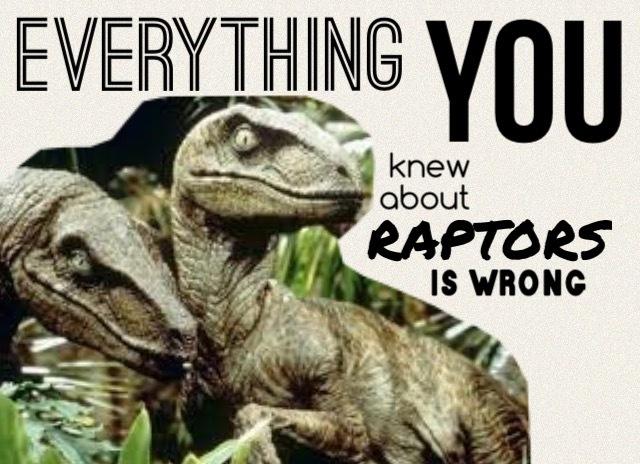Five Fun Facts about Dinosaurs
The velociraptor, pictured above, is not all that you think them to be. Velociraptors, the stars of movies like Jurassic Park, every sequel after, and Jurassic World, were actually the size of lapdogs. They also had feathers.
February 23, 2016
Growing up, there is always a time in one’s life where the idea of dinosaurs, gigantic beings larger than one’s infinite imagination can even fathom, is practically an obsession. Childhood memories of Jurassic Park, hiding underneath one’s own blanket and covering one’s eyes when the Tyrannosaurus Rex roars into the dark night, are prominent. I myself can remember waking up trembling from the thought of velociraptors chasing after me—and I have never been fast. There is something fascinating in the things that scare us as people, and that is why we obsess over these prehistoric, massive reptiles. They have the perfect amount of mystery and danger to intrigue us.
Unfortunately, much of what media has been feeding us is not entirely accurate. For one thing, raptors, as pictured in Jurassic Park, every sequel after, and the newest re-installment of Jurassic World where capitalism proves to be the true enemy, are more like turkeys in both intelligence and appearance than they are reptilian menaces. If anything, that makes it worse; imagine being torn to pieces by a scaly turkey. Here starts our dinosaur-myths countdown: the debatably most well-known dinosaur, the velociraptor.
- Velociraptors are not nearly as cool as you think they are. Sorry.
Most of what you know about raptors involves the imagery of gigantic reptiles as tall as a grown man and the intelligence of something a lot smarter than actual velociraptors, even though 1) paleontologists find raptor fossils that are a fourth the size of cinematically-depicted raptors and 2) their brain was more like the size of a fist—in fact, they do not even make it into the top ten of smartest dinosaurs. Realistically speaking, the velociraptors seen in Jurassic Park and every variation thereafter more likely resemble the deinonychus, the velociraptor’s larger and smarter distant relative. While the makers of Jurassic Park got the velociraptor’s curved hind claw right (which happens to be a diagnostic trait of all raptors—here is an extensive list of all of the velociraptor’s distant cousins), the makers seemed to miss the fact that velociraptors had feathers, even though, like many modern birds of this age, they were unable to fly due to their small arms, which could not extend far enough for them to gain wind under their feathers. Despite the flawed ideology that the cinematic world has created for us about velociraptors, I am sure the prehistoric turkeys would be flattered that they went down in history far more menacing-looking than they actually were.
- Tyrannosaurus Rex’s skulls can hold a lot of snot.
That is not a sentence one usually associates with the T-rex. With a name meaning “the king of tyrant lizards”, one is not too surprised to find out that the Tyrannosaurus Rex stood at 13feet at the hips and forty feet long, but I certainly was surprised that Ohio University, using technologically advanced 3D imaging, could discover that a Tyrannosaurus Rex’s skull could hold seven gallons of snot. In fact, the majority of the T-rex’s skull is composed of gigantic sinuses, but one cannot be too surprised by that number considering a T-rex’s skull weighs about nine tons—that is 1200 microwaves or 60 refrigerators.
- Baby dinosaurs were really
There is a biological reason that when human beings see babies, we want to squeeze them, and there are a certain number of traits that humans find inherently adorable: a large, rounded head relative to body size, large eyes, protruding, round cheeks, and a soft body shape. Dinosaurs, despite the image of scaly, angular creatures born with only dangerous instincts, had these same features for optimum cuteness. This conclusion was reached by John Whitlock, a paleontologist at the University of Michigan, who studied the differences in adult Diplodocus skulls and juvenile Diplodocus skulls. Although juvenile dinosaur skulls are rare, they provide substantial amounts of evidence regarding dinosaur maturity and what dinosaurs looked like through certain stages of life. The diplodocus, a ten-ton sauropod, has distinguished, squared snout that differs from other sauropods, such as the brontosaurus, which have rounded snouts. However, a juvenile diplodocus skull rediscovered at Pittsburgh’s Carnegie Museum of Natural History pointed towards the differences that baby dinosaurs and adults dinosaurs have, seeing as the juvenile skull sported a pointed snout. Scientists suspect that the shape difference is due to the baby diplodocus’ childish pickiness when it comes to food. Similarly to human children, scientists theorize that baby diplodocus had a narrower, pointier snout for picking through plants to find the most delicious parts.
- Dinosaurs come in all shapes in sizes, including something that scientists call “thunder thighs.”
The brontomerus, a sauropod presumed to have lived at the same time as raptors in the early Cretaceous Period, has a distinguished feature not found in other sauropods: massive, strong, gigantic “thunder thighs.” Discovered by scientists extending internationally from the United States and Britain, the Brontomerus distinguished itself as its own species by its unusually large hip bone, one of the few bones of the incomplete skeleton that scientists discovered. Two specimens of fossilized bones, one adult and one juvenile, were published in Acta Palaeontologica Polonica, a paleontological journal. Scientists deduced that the thick-thighed dinosaur would have weighed six tons, equivalent to that of a large elephant, and much of the weight would have come from the brontomerus’ un-proportionally large thighs, which is decided to be the largest thigh and hip bones of the sauropod family. The Brontomerus—which literally means “thunder thighs”—is described as “a charismatic dinosaur and an exciting discovery for us” by Dr. Mike Taylor, a researcher in the Department of Earth Sciences at University College London. Dr. Taylor and his team of scientists drew the conclusion that the massive thigh muscles were most likely used for kicking during mating season in order to show dominance to other males, similarly to the fighting done between modern animals like elephants during mating season. Since the large muscles also appear in female brontomeruses, a conclusion that the kicking was used for walking hilly terrain or as a defense mechanism is also likely.
- Most dinosaurs were… stupid.
Maybe they were not exactly stupid, but scientists have not found any proof that they were smart either due to the fact that fossilized dinosaur brains are extremely rare. The suspected smartest dinosaur was the Troodon, a carnivorous hunter that was seven feet long with sophisticated means of hunting and trapping prey, and its brain was large compared to the rest of its body. However, it was still suspected to have the intelligence of a modern bird. Scientists deduce the intelligence of dinosaurs by the size of their brain relative to the overall size of their body, and due to the fact that most dinosaurs, such as the ampelosaurus or the stegosaurus (which, in fact, has a brain the size of a ping pong ball and the body of a truck), have a brain the size of a tennis ball, scientists reach the conclusion that most dinosaurs were not all that smart. In fact, most dinosaurs’ brains were smaller than the size of a newborn human’s.
Links
Turkeys – http://www.livescience.com/4616-jurassic-park-villain-feathers.html
Deinochysus – https://www.q-files.com/images/pages/galleries/598/deinonychus-1.jpg
Relative – https://en.wikipedia.org/wiki/Deinonychus
Here- http://dinosaurs.about.com/od/typesofdinosaurs/a/raptors.htm
Ohio University -http://www.ohio-forum.com/2013/09/how-much-snot-does-a-t-rex-sneeze/
Snot – https://www.youtube.com/watch?v=lkonZ5SaNfc
Babies – https://www.baby-connect.com/images/baby2.gif
Adorable – http://www.stuffyoushouldknow.com/blog/babies-cute-explained/
Cuteness- http://www.livescience.com/6263-dinosaur-tots-baby-faced.html
Thunder thighs – http://www.telegraph.co.uk/news/science/dinosaurs/8340939/Dinosaur-discovery-new-thunder-thighs-dinosaur-discovered-by-British-scientists.html














